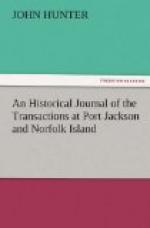The live-oak, yellow-wood, black-wood, and beech, are all of a close grain, and durable; in general they are from fourteen to twenty inches diameter. The branches of the live-oak are fit for timbers and knees of boats or small vessels.
There are a variety of other small trees on the island, but as they are not useful, it is unnecessary to enumerate them here; though I should not omit the fern-tree, the bark of which serves many purposes, instead of twine and rope. The cabbage-palm were in great plenty when I first landed on the island, but, by continual cutting, they were almost destroyed. There is a plant among the underwood, which produces a kind of pepper; its leaves are broad, and have an aromatic, pungent taste: the core which contains the seed, shoots out between the leaf and the stalk, and is in general two or three inches long, and full of small seeds, which have nearly the same taste as the leaves; but, on their being dried, the smell and taste leaves them: it is also difficult to find them in a state of ripeness, as the parroquets destroy them before they can arrive at any degree of perfection.
The flax-plant of New Zealand, grows spontaneously, and in great quantities on many parts of the island, but chiefly on the coasts and in the vallies near the sea: the leaves of this plant, when full grown, are from six to eight feet long, and six inches wide at the bottom: each plant contains seven leaves, and a woody stalk rises from the center, which bears the flowers: it seeds annually, and the old leaves are forced off by the young one every year. The method of soaking and preparing European flax and hemp, had been tried, but with no other effect than separating the vegetable part from the fibres; and a ligneous substance still remaining, it could not be reduced to an useful state. Some lines have been made of it, but they were not very strong; though the flax appears capable of being worked into a very fine substance, if the method of preparing it were known.




